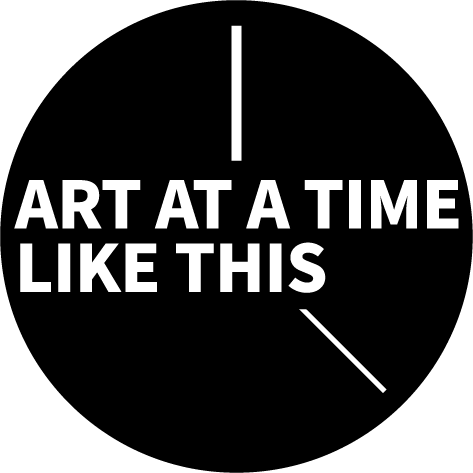
Tiffany Chung
While The World Stands Still
As the pandemic hit home, unprecedented challenges have prompted artists to rethink about our practices in terms of practicality, as well as in response to the current state of the world. With most parts of the globe in lockdowns, we were forced to take a long pause. I was able to reflect on the two decades of my artistic practice while resorting to poetry writing through sober observation of current social conditions, as a way to comprehend all that were happening. Through such process, I’ve rediscovered a kindred spirit in my earlier works, which critically explored urban progress and transformation in relations to extreme climate impacts and human destructions, envisioning the collapse of modern society and of humankind.
(L) roaming with the dawn: snow drifts, rain falls, desert wind blows; 2012; 4,000 hand-formed miniature glass animals; plinth approx. 1,000 x 700 x 60cm. 2012 Asia Pacific Triennale, GOMA, Brisbane, Australia.
(R) falling blue sky, frozen raindrops; 2012; steel and tin roof; 976 x 707 x 296cm. Kuandu Biennale, Kuandu Fine Art Museum, Taipei, Taiwan.
As choreographed / achingly and awkwardly / we step left and right.
We move up and down / in a quagmire of progress / of ruins and rubble.
Tomorrow is here, / the angel of history / awakens the dead.
Cities at a pause / thoughts, secrets, unfinished loves / are six feet under.
Behind glass windows / we breathe in the silence of / our befallen world.
Omnipotently / trees rustle in mighty winds / flowers bloom, birds sing.
Snow drifts and rain falls / sun rises and night recedes / while the world stands still.
And while we’re fumbling to figure out the ways forward with the pandemic still hovering above us, global protests have broken out in a renewed call for an end to systemic racism and police brutality against black bodies. Such sweeping powers urge us to ask ourselves what we must do as artists, as human beings, and as participants of a broken system and of the American Dream as a failing experiment. We’ve all been wrapped up in our own ambitions and therefore greatly lack social compassion. I’ve read somewhere that each and everyone we meet is fighting their own battle, so be kind. Although the impact varies on different communities, we’ve all been fighting this pandemic together – perhaps we can pause to think about someone else’s battle for a change. If everyone in all walks of life starts doing just that, I dare to dream that we will arrive at some real changes. And I believe it all starts with pondering and questioning the system.
8:30PM / he grabs some coffee and goes / working through the night.
Do you have facemasks? / Workers look at him and laugh / where can we find them?
No stimulus checks / an invisible workforce / we exist to serve.
Socially apart / we dream and look to the sky / in all four seasons.
On the way to pick up some food during the lockdown, my car stopped at an intersection. A young, white woman in a sports bra and a pair of ultra-short shorts jogged past the scalfold of a construction site, where a group of Latin American workers were hanging above and working under the scorching sun of an early Texas summer; their brown skin was covered with hats and long sleeves. That mental snapshot of paradox is filed in a cabinet of my consciousness, among many of the like. I often reorganize those ‘library index cards’ as I continue to collect material witnesses in my search for the rootcauses of economic disparities, social inequalities and forced displacement. When I sought to understand migration from the Northern Triangle of Central America to the U.S., with Guatemala as a case study, unpacking the country’s recent history intertwined with the U.S. economic interests and political influences has proven to be a pivotal key to understand why Guatemalans risk their lives heading north. Many of these undocumented migrants end up at construction sites without proper job training, especially basic safety procedures. Last year, a friend’s brother died in a work-related accident in Houston soon after arriving from Quiché was a case in point. Such accidents are mostly overlooked while migrants continue to do heavy-labor types of work in construction, farming and domestic service industry. Living in poverty while fearing deportation is the order of the day for many of them. As I’ve been revisiting the disgraced history of ‘human zoos’ in the western world and the transatlantic slave trade, my continuous questioning of history – for whom and through whose lenses history as we know has been written – is a quest from which more questions derive. This demands more learning of the relationship between economic interest, self-entitlement, racial hierachy, prejudice, and institutional injustice. As we’re witnessing history being rewritten through recent events, the distinction between art, politics and activism becomes more blurry than ever.
El Pulpo: UFCo’s Great White Fleet routes and properties in Central America & the Caribbean; 2019; embroidery on fabric; 55 x 55 in.
Guatemala Human Rights Commission: selected cases of violence in relations to current mega projects; 2019; acrylic, ink and oil on vellum & paper; 28 x 34 ¾ in.
installation shot
(L) Guatemala Memorial – selected names from Diario Militar & GHRC Tracking Human Rights; 2019; embroidery on fabric; 10 x 14 in./each of 120 pieces; overall dimension: 120 x 140 ½ in.
(R) Guatemala – Memory of Silence, CEH report: number of massacres by Department; 2019; acrylic, ink and oil on vellum & paper; 38 x 24 ¾ in.





